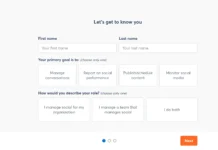
With social media evolving every day, there is an ever-growing amount of social media websites popping up, but which are the top most used social media websites? For this article, we’ve taken into consideration the social media websites that have the largest number of monthly active users, as ranked by Statista in January 2022.
This list includes not only social media websites and platforms but also microblogging and instant messaging apps as well.
So without further ado, let’s get to it!
| 1. Facebook 2. YouTube 3. WhatsApp 4. Instagram 5. WeChat 6. TikTok 7. Messenger 8. Douyin | 9. QQ 10. Sina Weibo 11. Kuaishou 12. Snapchat 13. Telegram 14. Pinterest 15. Twitter |
Top 15 Social Media Websites
1. Facebook

Country of Origin: United States
Monthly Active Users: 2.91 billion
Parent Company: Meta Platforms, Inc.
Launched In: 2004
Facebook is best known for being the first notable social media website created in 2004 by Mark Zuckerberg and a few of his Harvard colleagues, and for being the most used social media platform, with 2.91 billion monthly active users. It is owned by Meta Platforms, Inc., simply known as Meta in the business world, and formerly known as Facebook, Inc. With over a third of the world population (nearly 37%) using the social media platform actively, it’s clear that a lot of people love Facebook, but issues and complaints are also bound to happen with such a large user base.
Facebook has been involved in a lot of scandals like interfering with the 2016 presidential elections or exposing users’ personal photos, data, and private messages. Still, most people don’t seem to be bothered enough to give up on the social platform. In fact, in a study conducted by the Washington Post in collaboration with an economist from Tufts University and an associate professor of public relations and social media at Michigan State University, where Facebook users participated in auctions in which the lowest bidder was paid to deactivate their account, it was revealed that the average user would ask for $1,000 to deactivate their Facebook account for a year. Facebook is the best social media website for socializing, and people value a lot the ability to connect with their friends and family, invite them to events, be part of closed communities with Facebook Groups, and post status updates, so it’s hard to imagine giving it up anytime soon.
2. YouTube

Country of Origin: United States
Monthly Active Users: 2.6 billion
Parent Company: Alphabet, Inc.
Launched In: 2005
YouTube is the best online video-sharing and social media platform. Launched in 2005 by Steve Chen, Chad Hurley, and Jawed Karim, YouTube was acquired by Google for $1.65 billion just 18 months after posting the first video. Today, it has a total of 51 million YouTube channels, uploading 500 hours of video every minute, and users are watching a total of 1 billion hours every single day (see more YouTube statistics here). YouTube was one of the first social media platforms where influencers were created and creators had the ability to build a career out of just posting videos. However, many users have complained about YouTube’s copyright issues, violation of user privacy, excessive censorship, and inability to protect children enough.
3. WhatsApp

Country of Origin: United States
Monthly Active Users: 2 billion
Parent Company: Meta Platforms, Inc.
Launched In: 2009
WhatsApp is the most used instant messaging app, with more than 2 billion users. Users can send text and voice messages, make voice or video calls, and share images and other content with end-to-end encryption. WhatsApp is mostly used on mobile devices, but it has a desktop application as well, which requires your mobile phone to permanently be connected to the Internet. However, this works only in theory, and I’ve experienced frequent disconnects on my desktop app, even though my phone was right next to my laptop. Their latest desktop update (currently at version 2.2214.12), however, is doing much better, allowing you to use WhatsApp on up to four linked devices at the same time, without requiring your phone to be online. WhatsApp was acquired by Facebook in 2014, so it’s no surprise that it’s accused of mostly the same stuff Facebook has been accused of: the spread of misinformation, security and privacy breaches, and a large number of scams and malware.
4. Instagram

Country of Origin: United States
Monthly Active Users: 1.47 billion
Parent Company: Meta Platforms, Inc.
Launched In: 2010
Instagram is the best-known photo and video-sharing social media platform, founded in 2010 by Kevin Systrom and Mike Krieger, and acquired by Facebook in 2012 for $1 billion. Launched only on iOS originally, Instagram became extremely popular very fast, with over 10 million users in the first year. Needless to say, when it was also launched on Android in 2012, the social media network exploded, and by 2018 it already had 1 billion users. People loved Instagram because it was the first social media website exclusively focused on images, and as we all know, people love sharing photos. In time, Instagram also introduced Stories, and later on short-form videos with Reels, and more recently in-feed videos that can be up to 60 minutes long. But as much as people love Instagram, it has also been heavily criticized for its heavy use of filters and editing, which negatively impacts the self-image of many people, especially teenage girls. Instagram has also been criticized for presenting a “highlight reel” version of reality, which makes a lot of people experience mental health issues and extreme FOMO (fear of missing out).
5. WeChat

Country of Origin: China
Monthly Active Users: 1.26 billion
Parent Company: Tencent
Launched In: 2011
Launched in 2011, WeChat, formerly known as Weixin, is a Chinese instant messaging app similar to WhatsApp, but with so many more functionalities. Like WhatsApp, WeChat allows you to perform basic messaging app actions like sending messages, files, and making video calls, but it also offers video conferencing, gaming, and mobile payment features. Developed by Tencent in 2011 as an alternative to their desktop messenger app, QQ, WeChat is, like all other apps in China, analyzed and tracked by the Chinese authorities in an effort to censor and control the population.
6. TikTok

Country of Origin: China
Monthly Active Users: 1 billion
Parent Company: ByteDance Ltd.
Launched In: 2017
TikTok was launched in 2016 by ByteDance as a response to the huge success of its Chinese counterpart, Douyin, and it has become the most popular video-sharing social media network. TikTok features a wide variety of short-form videos on topics like cooking, health, life hacks, dancing, pranks, and other types of entertainment or even educational videos. It currently has 1 billion monthly active users, and according to Statista, as of April 2021, six percent of TikTok users spend more than ten hours per week on the platform. Another 11% spend between 5 to 10 hours a week, another 15% spend between 2 to 5 hours a week, and 30% spend less than one hour a week on the platform. These are quite staggering numbers and seem to be clearly leaning toward addiction, or even indicating social media addiction in some cases. And it’s not surprising, as the social media website makes it easy to swipe from one video to the other until you find yourself spending hours on end pointlessly.
7. Messenger

Country of Origin: United States
Monthly Active Users: 988 million
Parent Company: Meta Platforms, Inc.
Launched In: 2011
Messenger is Facebook’s revamped version of Facebook Chat, which was launched in 2008. There are several ways you can access Messenger’s instant messaging services: through its dedicated web interface, at Messenger.com, through one of its standalone iOS and Android apps, through one of its desktop apps launched in 2020 for Windows and macOS, or directly from your Facebook account. Whichever one you pick, you can perform the same services as with most other instant messaging apps: send messages, share photos and other files, use stickers and emojis, and make voice or video calls. Messenger also has a video conferencing feature available, called Messenger Rooms, which allows users to add up to 50 people to a conference without the need for a Facebook account and without restrictions on time. However, unlike other popular video conferencing services like Zoom or Skype, Messenger Rooms does not use end-to-end encryption and there have been complaints about Facebook’s handling of data and lack of privacy protection.
8. Douyin

Country of Origin: China
Monthly Active Users: 600 million
Parent Company: ByteDance Ltd.
Launched In: 2016
As mentioned above, Douyin is the Chinese version of TikTok, and it was the first one launched out of the two social media apps, in September 2016. TikTok and Douyin are very similar, with almost the same user interface, but the features are not quite identical, and users don’t have access to the other app’s content. Unlike TikTok, Douyin also features an in-video search that allows users to search by face to find more videos from the same creator, as well as geo-tagged reviews and hotel bookings, among others. In October 2021, both Douyin and Kuaishou (another video-sharing mobile app) were fined $31,000 for violating China’s advertising law by publishing a controversial microloan advertisement that encouraged “excessive consumption”, according to government records.
9. QQ

Country of Origin: China
Monthly Active Users: 574 million
Parent Company: Tencent
Launched In: 1999
Tencent QQ, also known as QQ, is an instant messaging software service and web portal that offers services like online social games, music, shopping, microblogging, movies, and group and voice chat software. Tencent currently offers a premium membership where members can enjoy features such as QQ mobile, ringtone downloads, and SMS sending/receiving. In addition, Tencent offers “Diamond” level memberships that give access to extra features like extra storage, special abilities in games, online music streaming, and ad-free chat depending on the diamond color you choose. QQ has also introduced a virtual coin used to purchase stuff for users’ avatars and blogs, but it has also been accepted by real-life vendors in some places.
10. Sina Weibo

Country of Origin: China
Monthly Active Users: 573 million
Parent Company: Sina Corporation
Launched In: 2009
Sina Weibo is a microblogging website believed by many to be the Chinese alternative to Twitter, with over 573 million active users. Users can share posts limited to 140 characters, post images and stories, send instant messages, and follow other accounts. Weibo has seen great financial success, surpassing the $30 billion stock market valuation mark for the first time at the start of 2018. However, Sina Weibo has been criticized for censoring its users, which is not surprising given it’s a China-based app.
11. Kuaishou

Country of Origin: China
Monthly Active Users: 573 million
Parent Company: Beijing Kuaishou Technology Co., Ltd.
Launched In: 2011
Kuaishou is a Chinese video-sharing social media app similar to TikTok and Douyin. Outside China, it has also become popular in countries like Brazil, Indonesia, and Pakistan. In 2020, Kuaishou was the most downloaded app both in Google Play and Apple’s App Store in eight countries. In 2021, Kuaishou showed a 16.6% increase in daily active users compared to 2020, with users spending an average of 100 minutes a day on the app, so it’s coming strong from behind and perhaps even threatening to take TikTok’s crown at some point? It remains to be seen. What’s certain is that it’s doing very well, boasting a nearly 49% increase in revenue in 2021 compared to the previous year. This comes even after being briefly banned in China in 2018 when it was reported to be promoting videos of teenage mothers.
12. Snapchat

Country of Origin: United States
Monthly Active Users: 557 million
Parent Company: Snap Inc.
Launched In: 2011
Snapchat is a multimedia instant messaging social media app developed by Snap Inc. in 2011. The app was initially just a personal photo-sharing app, but it evolved into letting users share photos and video stories that are presented chronologically and only available for 24 hours before they permanently disappear. In fact, this is the main difference with Snapchat. While other popular social media websites like Facebook and Instagram value the permanence of their content, Snapchat’s whole model was built around having its content be ephemeral and ever-changing. In fact, intrigued by this idea, Mark Zuckerberg tried to buy Snapchat in 2013 for a reported $3 billion, but the CEO of Snapchat turned down the offer. This is probably the reason Instagram launched its own fleeting Stories in 2016, which were clearly inspired by Snapchat’s model. But even if people have the alternative of Instagram Stories now, many users still remain loyal to Snapchat because it has its own appeal that not many understand.
13. Telegram

Country of Origin: United Arab Emirates
Monthly Active Users: 550 million
Parent Company: Telegram
Launched In: 2013
Telegram is a freeware, cross-platform, cloud-based instant messaging service launched in 2013. What sets it apart from other instant messaging apps is that, unlike WhatsApp for example, Telegram only uses end-to-end encryption in its “Secret Chats” Mode. However, once that’s activated, all messages and files will be encrypted and you can set a timer for the messages and photos to automatically self-destruct. Another feature that differentiates Telegram from other IM apps is that it has self-installed bots, which are sort of like assistants that help you set reminders, play music, create to-do lists, check the weather, and other similar actions. What’s also interesting is that Telegram’s operational center is based in Dubai, but it uses five different data centers located worldwide to store its information and decrease frequent data load. Telegram has official apps for iOS, Android, macOS, Windows, and even Linux.
14. Pinterest

Country of Origin: United States
Monthly Active Users: 444 million
Parent Company: Pinterest
Launched In: 2009
Pinterest is the best image-sharing social media website for people interested in saving photos for recipes, DIYs, tips & tricks, life hacks, etc. With how many people I know who are obsessed with Pinterest, I’m actually surprised it doesn’t have even more active users. Pinterest is great for pinning images to a board and creating a collection of inspiring images for different projects, such as renovations, curating a new wardrobe, saving hairstyle inspirations for a wedding, and finding what you like from a selection of images where you can eventually identify a repeating pattern. But these are just a few examples of what you can do with Pinterest. The only limit is your imagination.
15. Twitter

Country of Origin: United States
Monthly Active Users: 436 million
Parent Company: Twitter, Inc.
Launched In: 2006
Twitter is the most famous and long-lasting microblogging and social networking service where users can post short messages known as tweets in an SMS-style fashion but visible to the whole world. Twitter was accused by some that it was restricting the right to free speech when President Donald Trump was banned from the platform, while many others agree that it was the right thing to do. Even Elon Musk, the CEO of SpaceX and Tesla, accused Twitter that it doesn’t rigorously adhere to the principle of free speech, and eventually made a decision to buy the platform and change it himself. On April 25, 2022, the Twitter board actually agreed to sell Twitter to Elon Musk for $44 billion, which is quite a shocking decision, I must say. If you haven’t watched the whole Elon Musk-Twitter saga, you can read more about it here. I believe we’re in for a ride, wherever Elon Musk decides to take this.
Conclusion
Facebook, or rather Meta Platforms, Inc., owns four of the most active social media websites, which is quite interesting, with ByteDance Ltd. and Tencent owning two each. Of our top 15 social media websites, eight are American, six are Chinese, and one is Arabian. It will be interesting to see how this develops over time. If you post on multiple of these networks, you might consider some social media automation tools.
See also: Who has the most followers on Instagram?











